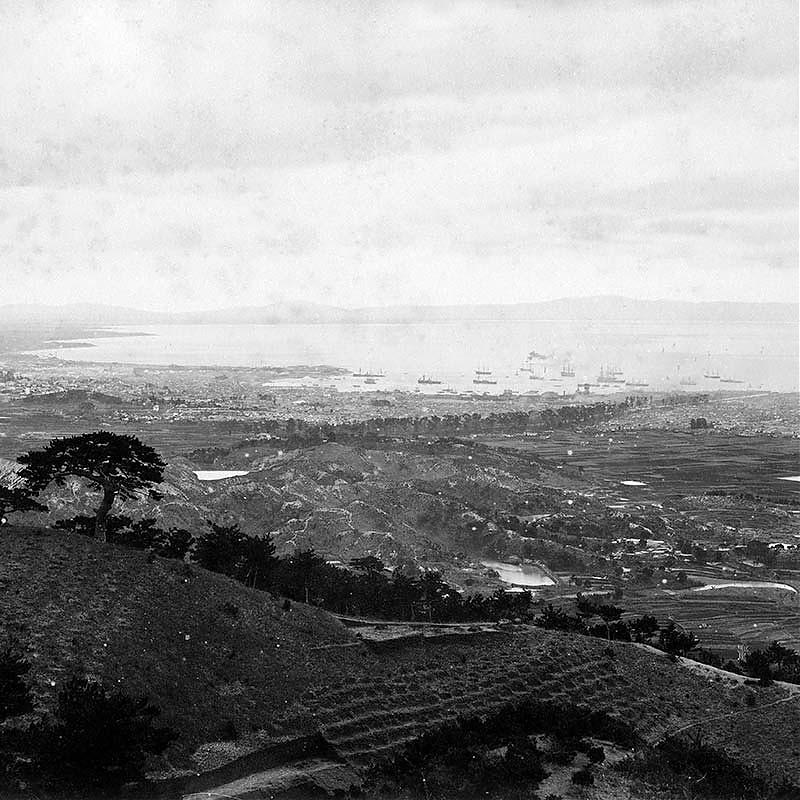A splendid view on Shijo Ohashi bridge, one of Kyoto’s most important bridges on the river Kamogawa.
Crossing the bridge and walking towards the mountains brought visitors to Yasaka Jinja, the shinto shrine that originated the famous Gion Matsuri. The road towards Yasaka Jinja is quite wide nowadays, but on this photo it is still narrow.
The crowd on the bridge includes rickshaws and pedestrians holding Western style umbrellas. To distinguish them from Japanese umbrellas, these were called Komorigasa, literally bat umbrellas.
According to temple records (社家記録) of Yahata Jinja, the first bridge at this location was built in 1142 (Eiji 2). It wasn’t yet called Ohashi (literally “large bridge”) because it was a small bridge. This bridge however played an important role in Kyoto as it allowed both the Gion procession and pilgrims visiting the shrine to cross the Kamogawa.
The first Shijo Ohashi was completed in 1857 (Ansei 4). It consisted of a wooden bridge on stone pillars.
Because of the river Kamogawa’s recurrent flooding, bridges were often washed away. A fate that repeatedly befell the old Shijo bridge as well. It therefore didn’t make sense to build expensive big bridges.
Instead, the people of Kyoto used ferries or built simple bridges. These usually reached from both banks unto one of the many sandbars in the river, which were filled with small restaurants and theaters. When such bridges were destroyed in floods, they were quickly rebuilt at small expense. An unrelated, but interesting aspect of these Kamogawa bridges was that they were separated into bridges for pedestrian use and bridges for the transportation of goods.

The first Shijo Ohashi might have been big and have stone pillars, but it too was washed away during a flood in 1873 (Meiji 6). A new bridge, the one of this photograph, was completed in April 1874 (Meiji 7). It was made of iron and had four lamps on each side, and like all new bridges of the time, reached from bank to bank.1
Although this scene might appear traditional and nostalgic to us, to the inhabitants of Kyoto of this time it must have appeared very modern. The bridge was made of iron, people used Western umbrellas, there were lots of rickshaws, there was a large ad for Asahi Beer, and there were electricity poles alongside the bridge. All of them Meiji innovations.
These poles actually help to date this photograph. Kyoto’s electricity company, Kyoto Dento Gaisha (京都電灯会社), started operations in July 1889 (Meiji 22), so this photograph was taken after this date. Because the Yaami Hotel (也阿弥ホテル), which can be seen on the mountainside (Maruyama) in the far background, was severely damaged by fire on March 25, 1899 (Meiji 32), we know that this photo was taken before 1899. Most probably in the second half of the 1890s.2
In 1913 (Taisho 2), when Kyoto roads were widened to accommodate streetcars, once again a new bridge was built. This time it was made of concrete and featured an arched design (see Kyoto 1926 • Kamo River). This design caused much trouble however during a flood in 1935 (Showa 10). Driftwood got stuck in the arches and the resulting flood created havoc in the nearby areas. So in 1942 (Showa 17), once again a new bridge was built. This bridge stands to this day.3
For another view of the river Kamogawa, see Kyoto 1890s • Kamogawa.

Notes
1 白幡洋三郎 (2004)。幕末・維新彩色の京都, 京都: 京都新聞出版センター, 38。ISBN 4763805312
2 京都ホテル100年ものがたり 。26.「也阿弥ホテル」の火事。 Retrieved on 2008/07/01.
3 ウィキペディア。四条大橋。Retrieved on 2008/07/01.
Published
Updated
Reader Supported
Old Photos of Japan aims to be your personal museum for Japan's visual heritage and to bring the experiences of everyday life in old Japan to you.
To enhance our understanding of Japanese culture and society I track down, acquire, archive, and research images of everyday life, and give them context.
I share what I have found for free on this site, without ads or selling your data.
Your support helps me to continue doing so, and ensures that this exceptional visual heritage will not be lost and forgotten.
Thank you,
Kjeld Duits
Reference for Citations
Duits, Kjeld (). Kyoto 1890s: Shijo Ohashi, OLD PHOTOS of JAPAN. Retrieved on December 12, 2025 (GMT) from https://www.oldphotosjapan.com/photos/291/shijo-ohashi




There are currently no comments on this article.